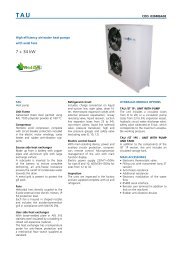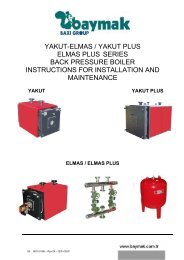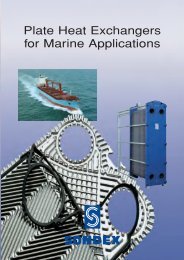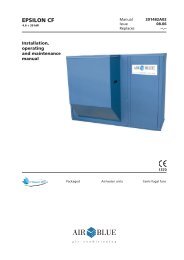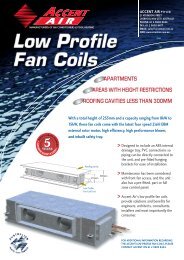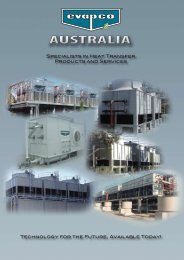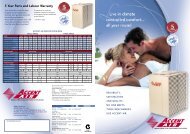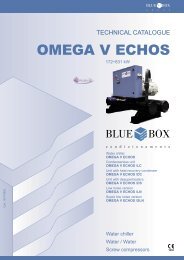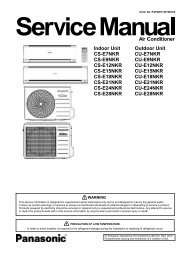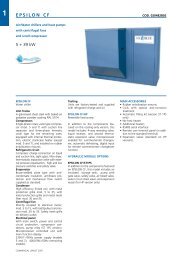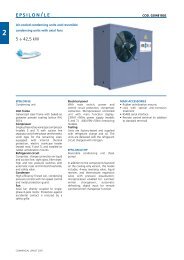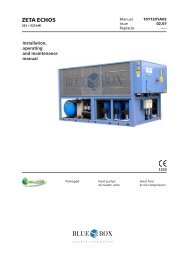KAPPA V ECHOS AC IOM.pdf - Industrial Air
KAPPA V ECHOS AC IOM.pdf - Industrial Air
KAPPA V ECHOS AC IOM.pdf - Industrial Air
You also want an ePaper? Increase the reach of your titles
YUMPU automatically turns print PDFs into web optimized ePapers that Google loves.
7.2.15 Defrosting (heat pump units only)<br />
During winter heat pump mode operation the finned coil of the air cooled condenser functions as an evaporator,<br />
cooling and dehumidifying ambient air.<br />
During heat pump operation, the evaporation pressure is monitored to prevent it from falling below a preset<br />
value. The evaporation control is active only during heating mode operation.<br />
Depending on the ambient air temperature and humidity conditions, condensate or frost will tend to form,<br />
consequently obstructing the free passage of air and causing thermal insulation. The frost that builds up on the<br />
coil obstructs the passage of air and reduces the available heat exchange surface area (and thus the thermal<br />
efficiency) and can damage the heat exchanger.<br />
Defrosting is the procedure that eliminates the ice that has formed on the evaporator coil during heat pump mode<br />
operation of an air/water unit.<br />
Defrosting is performed simultaneously for the entire unit.<br />
All heat pump versions are equipped with a control that activates an automatic coil defrost cycle when necessary.<br />
After starting however, the first defrost cycle will be started after a preset minimum operating time to allow the<br />
formation of sufficient thermal inertia to allow the cycle to be completed successfully.<br />
Defrost cycle activation is based on the detection of a low suction pressure value due to insufficient heat exchange<br />
between the evaporator and the air due to the formation of a layer of ice, which exerts a thermal insulation<br />
effect. For a defrost cycle to be able to start a suction pressure of at least one of the currently operating compressors<br />
must remain below the pressure set for the defrost cycle trip signal for a preset time interval.<br />
Before starting to defrost the coils, all the compressors are started, after which the unit reverses its operation from<br />
heat pump to chiller mode.<br />
When the cycle is reversed the fans stop and the compressors force hot gas into the coil.<br />
A pressure switch on the high pressure circuit maintains the discharge gas pressure below the defrost end value.<br />
To maintain the pressure lower than the defrost end pressure the pressure switch activates the fans.<br />
To reduce the air flow and obtain more efficient heating of the outer part of the coil, the pressure switch signal<br />
causes the fans to rotate in reverse.<br />
When the defrost end temperature is reached, as measured by a thermostat with a probe located in the lower<br />
part of the coil, the pressure switch allows the discharge pressure to reach the defrost end pressure.<br />
When the defrost end pressure has been reached, the controller reverses the unit from chiller mode to heat pump<br />
mode, thereby terminating the defrost procedure.<br />
Even though in certain conditions the surface temperature of the coil and the condensation pressure fail to reach<br />
the defrost values within the preset time limit, the defrost cycle is forcibly terminated as though the defrost end<br />
signal were present. The controller restarts the fans, and when the pressure lowers again to the preset value, it<br />
reverses the unit’s operating mode again.<br />
If the defrost cycle is forcibly interrupted, with the timeout signal, a message is displayed on the controller,<br />
although no controller functions are activated.<br />
The defrost timeout alarm is automatically cleared from the active alarms menus when a defrost cycle terminates<br />
normally because the defrost end pressure has been reached. In any event, the alarms historical file will contain<br />
a record of all defrost cycles that were terminated forcibly due to a timeout intervention.<br />
Consecutive defrost cycles must be at least 30 minutes apart. If the forced defrost signal persists, inform the<br />
Service organisation.<br />
7.2.16 Total heat recovery (option)<br />
Heat recovery is the function where all the energy that would normally be rejected to the air cooled condenser is<br />
recovered at a refrigerant to water condenser installed in series with the air-cooled condenser.<br />
The heat recovery process is managed by the microprocessor controller.<br />
During energy recovery the fans are stopped and the condensing coil is by-passed via solenoid valves connected<br />
downstream of the thermostat valve. The machine is equipped with a liquid receiver.<br />
Heat recovery can only occur when the water temperature at the recovery exchanger inlet is lower than the<br />
recovery set-point. Heat recovery is terminated when the temperature increases by the recovery differential<br />
value.<br />
It is mandatory to use a condensing pressure control valve (one for each hydraulic circuit) or three-way valve,<br />
fitted by the installer, to avoid condensation values that are incompatible with operation of the machine.<br />
Blue Box 44





